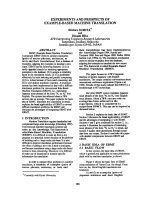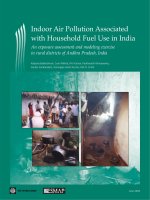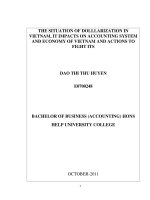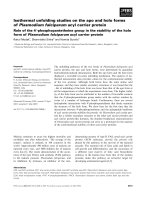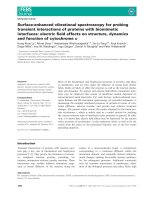studies on present problems and prospects of shrimp farming in west godavari district of andhra pradesh india
Bạn đang xem bản rút gọn của tài liệu. Xem và tải ngay bản đầy đủ của tài liệu tại đây (92.55 KB, 6 trang )
Available online at www.pelagiaresearchlibrary.com
Pelagia Research Library
Advances in Applied Science Research, 2016, 7(2):49-54
ISSN: 0976-8610
CODEN (USA): AASRFC
Studies on present problems and prospects of shrimp farming in west
Godavari district of Andhra Pradesh, India
D. Srinivas and Ch. Venkatrayalu
Department of Marine Biology, Vikrama Simhapuri University, Nellore, Andhra Pradesh, India
_____________________________________________________________________________________________
ABSTRACT
The commercial shrimp culture was introduced in late 1990s and reaching a peak in 1994 and thereafter it was
suddenly declined in the Andhra Pradesh. The series of white spot disease outbreaks, lack of quality seed and feed,
problems in quality brood stock, increased cost of production on account of feed, labour and the mandatory
certificates requirements are suggested to be some of the important factors leading to the production decline. While
majority of the output comes from Andhra Pradesh, particularly the East Godavari West Godavari, Krishna and
Nellore districts. The present work was carried out on data collected from 228 shrimp farms along with farmers in
different mandals of West Godavari district. The present trends indicate that the sector is set to revival, but the
future prospectus of shrimp farming will also depend on the sustenance of white leg shrimp Litopenaeus vannamei
that was introduced recently in India. Although it provided a hope and opportunity for sustainable shrimp farming,
some diseases are already reported. The main problems and constraints expressed by the farmers are discussed
according to the severity in the farming practices in shrimp culture. Availability of healthy and disease free seed is a
major problem for them. The possible suggestions are identified by the shrimp farmers are also discussed.
Keywords: Shrimp culture, West Godavari, Different Problems, Suggestions, Prospects.
_____________________________________________________________________________________________
INTRODUCTION
Shrimp farming has grown a traditional, small-scale business in Southeast Asia into a global industry (Joseph Selvin
et. al, 2009). In India extensive production systems of shrimp culture is more profitable (Leung & Engle 2006) than
the other culture systems. Technological advances have led to growing shrimp at even higher densities. Almost all
the farmed shrimp are penaeid group of the family Penaeidae and only two shrimp species tiger shrimp Penaeus
monodon and Pacific white shrimp Litopennaneus vannamei occupied more than 90% of the farmed shrimp
production. Krishnan and Birthal (2002) have also explained that due to the demand and growth of coastal aqua
culture in India, it also has been quite a promising sector for accelerating the exports and improving the foreign
exchange. The shrimp has been introduced and farmed in Asia since the mid 1990s, (Balakrishnan et al, 2011).
Development of shrimp farming is an important activity in coastal waters of Andhra Pradesh in India. The shrimp
production has grown at phenomenal rate during the year 1992-1994 and later started decreasing due to outbreak of
diseases. The rapid growth of shrimp farming led to an economic boom but, the out break of viral diseases has
increased the economic risks and slowed the industry development (Flegel, 2006). The Marine Products Export
Development Authority (MPEDA) in association with Network of Aquaculture Centres for Asia- Pacific (NACA)
has started a programme in Mogalthur, West Godavri district in 2002 which helped the farmers to adopt Better
Management Practices (BMPs) for disease control and sustainable farming. The programme was successful in
organising the small scale farmers into self help groups for adoptions of BMPs. However, the growth of shrimp
farming is slow between 1999-2009. During this time, freshwater prawn farming in India developed in 1999 due to
sudden surge in demand and in response to the decline in marine shrimp production caused by White Spot
Syndrome Virus and the Supreme Court judgement on coastal regulation zones (CRZ) (Mohanakumaran Nair and
Salin, 2006). The shrimp farming gained momentum after introduction of L. vannamei in 2009. The culture area and
49
Pelagia Research Library
D. Srinivas and Ch. Venkatrayalu
Adv. Appl. Sci. Res., 2016, 7(2):49-54
_____________________________________________________________________________
production of L. vannamei has been constantly increasing and the details shown in Table-1. In Andhra Pradesh, it
increased from 264 hectares of area to 37,560 hectares and the production increased from 1655 tonnes to 2,76,077
tonnes during 2009-10 to 2014-15.
Table -1: The area under culture and production levels of L. vannamei in Andhra Pradesh & rest of India (2009 – 2015)
Year
2009-10
2010-11
2011-12
2012-13
2013-14
2014-15
Area under culture in Ha
AP
Rest of the India Total
264
19
283
2739
192
2931
7128
709
7837
20198
2518
22716
49764
7503
57267
37560
12680
50240
Year
2009-10
2010-11
2011-12
2012-13
2013-14
2014-15
AP
1655
16913
75385
133135
210639
276077
Production in Tonnes
Rest of the India
Total
76
1731
1334
18247
5331
80716
14382
147517
39868
250507
77336
353413
(Source: MPEDA, 2015)
Further, Shrimp culture has been listed as one of the priority sectors in India by the Government for increasing
exports and thereby contributing to the foreign exchange reserves (Swathi Lekshmi et al., 2013). The shrimp and
marine exports from Andhra Pradesh has also been tremendously increased from Rs.2100 crores to Rs.14,200 crores
during the same period(MPEDA,2015). The farmers had first bred tiger variety Penaeus monodon and then shifted
to Litopenaeus vannamei and their earnings are increasing. Development of shrimp farming has contributed
enormously to the local economy as well as that of the State (Kumaran et. al., 2003). The present study was carried
out in West Godavari District of Andhra Pradesh to understand the nature of shrimp practices followed and its socio
economic status of local population, the influence of extension support and the constraints if any faced in the culture
and wants to highlight the issues and strategies for sustainable shrimp aquaculture.
Study area: West Godavari district lies between 16ο 15′ and 17ο 30 N and 80ο 55′ and 81ο 55′ E and has an area of
10,807 sq. km, with a population of 39, 95,742. It is a major rice producing region in the state with 56% of the total
area of the district under rice cultivation. Generally, farmers of the district culture both L. vannamei and tiger shrimp
Penaeus monodon, because of its high market value. Out of the 46 mandals of the district, 7 (Narsapur, Mogalthur,
Elamanchili, Palakol, Palakoderu, Veeravasaram, and Bhimavaram) mandals were chosen and detailed study was
carried out in 36 villages with respect to the culture practices, water, feed and health management followed by the
farmers. For the Socio - economic component of the study, data was collected from 228 randomly chosen shrimp
farmers using pre-tested questionnaire. Meetings of various stakeholders were held in 10 villages to assess the
impacts of shrimp farming in the study area.
MATERIALS AND METHODS
The present study was carried out on a data set of 228 shrimp farms along with farmers. The data was collected from
36 revenue villages spread over in 7 mandals of West Godavari district of Andhra Pradesh. The methodology
adopted in the present study differs from the earlier evaluation studies. We have collected data from the clusters
formed by the National Centre for Sustainable Aquaculture (NaCSA) for better reliable statistics. As the brackish
water culture is mostly in private sector and the culture is a dynamic environment, the actual figures some times
vary with the data collected from the respondents.
The sample design of the study: The study was adopted in three stage stratified purpose random sampling. The
West Godavari district is divided into four revenue divisions Narsapur, Eluru, Kovvuru, and Jangareddygudem.
Coastal mandals from the Narsapur division is only taken as the other three revenue divisions do not have brackish
water area. In the first stage, revenue mandals were selected based on the presence of brackish water area and areas
of low salinity where shrimp is cultivated. Several authors reported the growth and survival of L. vannamei in low
salinities of 1.7- 2.3 ppt of brackish water area (Bray et al., 1994; Moya et al.,1999;Samocha et al.,1999). In the
second stage of sample selection, 7 mandals and 36 villages which are having either the pure brackish water area or
areas of low saline waters. In the third stage, the selection of the farmers was made, in each selected village the
farmers were selected on the basis of their farm registration with Coastal Aquaculture Authority (CAA) of India
mainly. Farmers, who applied for registration with CAA having considerable farm area and experience, were also
interviewed. The various stakeholders were also interviewed along with farmers.
Surveys and data Collection: The present study made the use of secondary as well as primary data. The primary
data was mainly collected from farmers who are doing shrimp culture. The data is also collected from other
stakeholders viz. farmers associations members, community leaders, village elders, and non- shrimp farmers, to
analyse the present status and problems in shrimp culture. The secondary data on various parameters associated with
shrimp aquaculture were collected from district, state and national level agencies, district and field level
50
Pelagia Research Library
D. Srinivas and Ch. Venkatrayalu
Adv. Appl. Sci. Res., 2016, 7(2):49-54
_____________________________________________________________________________
governmental officials, non –officials, and NGOs. The methods adopted for this study include pre determined
schedule, discussions, surveys, rapid appraisal methods. The brief summary of the impact assessment methods
adopted by this study are presented in Table- 2.
Table – 2: Impact assessment methods adopted by the study
S.No.
1
2
Description of the Method
Survey Method
a) Farmers registered with CAA
b) Sample Survey
Rapid Appraisal Method
a) Focus group discussions
b) Semi Structured interview with key stakeholders /
informants
Description of the Units Covered
All farmers in the 36 villages
Selected shrimp farmers and non farmers or other stakeholders
Farmers and Non farmers
1. Various farmers associations members at Village, mandal and state
levels
2. Village elders, Community leaders and Knowledgeable
persons
3. Government officials
4. Non Governmental Organisations (NGOs)
Sources of the data: The primary data is collected by interviewing the farmers, who are presently doing the
culture and also from the farmers who have abandoned the culture recently. The opinions of the stake holders
including, feed manufacturers, seed suppliers, hatcheries operators, farm labourers, operators and owners of
processing and storage plant units are also taken. Certain information is also gathered from the shrimp exporters.
The secondary data is collected from the Department of Fisheries (DoF), Government of Andhra Pradesh, Marine
Products Export Development Authority,(MPEDA),Ministry of Commerce and Industry Government of India,
National Centre for Sustainable Aquaculture (NaCSA), a society of MPEDA, National Fisheries Development
Board (NFDB) Department of Animal Husbandry & Dairying and Fisheries, Ministry of Agriculture, Government
of India, Food and Agricultural Organisation (FAO) of United Nations Organisation, Office of the Deputy Director
of Fisheries, West Godavari district.
RESULTS AND DISCUSSION
A brief profile of the shrimp farmers of the district is presented in Table-3. It is evident that 54.8% of shrimp
farmers had education level of below 10th class (SSC), 41.7% were SSC, 0.9% are Intermediate, 2.2 % are graduate
and 0.4% is above graduation level. About more than three fourths of the farmers (92 %) had other occupations
(agriculture and business sectors) in addition to shrimp farming and only 8 % have Aquaculture as only occupation.
Most of the farmers are small farmers, having a farm size of less than 2 ha (86%) and about 14 % of them were
large farmers with more than 2 ha farming area. Most of the farmers had more than five years of farming experience
(96.9%). The villagers reported that, the development of shrimp farming helped to increase their income.
Table-3: Profile of the shrimp farmers in West Godavari District
Profile Characteristics
a) Education
Frequency Percentage
Below10th Class (SSC)
125
54.8
10th Class (SSC)
95
41.7
Intermediate (10+2)
2
0.9
Graduation
5
2.2
Above Graduation
1
0.4
228
100.0
Aquaculture + Other sectors
209
92
Aquaculture only
19
08
Total
228
100.0
1= < 2 ha
196
86.0
2= 2-5 ha
32
14.0
Total
b) Occupation
c) Farm size
d) Experience in culture
< 5 years
7
3.1
>5 years
221
96.9
51
Pelagia Research Library
D. Srinivas and Ch. Venkatrayalu
Adv. Appl. Sci. Res., 2016, 7(2):49-54
_____________________________________________________________________________
Extension Assistance:
More than half of the farmers had regular contact with feed suppliers and extension personnel of the Department of
Fisheries (DoF) and other fisheries institutional agencies. The topics of the discussion included issues such as seed
quality, disease management and feed management. Their major sources of information related to farming activity
were feed technicians, DoF personnel and others. The farmers of 10-15 % only had received training in shrimp
farming related areas conducted by State Institute of Fisheries Technology (SIFT), Kakinada and Marine Products
Export Development Authority (MPEDA). Most of them wished to have training in disease prevention, seed quality
detection, water quality management, application of probiotics and other advances in shrimp farming management
practices.
The main sources of the information received in related to shrimp farming by the farmers are given in Table 4. Most
of the shrimp farmers (40.35%) indicated that local feed technicians and feed traders were their main source of
information related to farming. The Local feed traders, due to their sharing arrangement with shrimp farmers,
regularly visited farmers and provided all necessary information. About 28.5% of respondents reported that
personnel from the department of fisheries provided them necessary information. 19.74% of farmers indicated that
institutional information sources like MPEDA and other fisheries research institutions were their information
sources. Private aqua consultants, printed literature like brochures. new letters and leaf lets from feed companies,
institutions and meetings, seminars, farmer discussions were the other sources of information.
Table 4: Information sources of the shrimp farmers
S. No
1
2
3
4
5
Information Source
Feed Technician
DoF Personnel
MPEDA
Private Aqua consultants
Other sources
Frequency (N=228)
92
65
45
20
6
Percentage
40.35
28.50
19.74
8.78
2.63
Rank
1
2
3
4
5
Problems and Constraints:
The main constraints expressed by the farmers are ranked according to their severity in Table 5. Viral and bacterial
disease outbreaks were considered as the major constraint by 66.67 % of the farmers. In the present study the most
common diseases observed are Black gill disease, IHHNV (Infectious Hypodermal and Hematopoietic necrosis
Virus), White muscle disease, White gut disease, Running Mortality syndrome and White spot syndrome virus
(WSSV). Lack of availability of quality shrimp seed from hatcheries is of great concern to 50.44% of the farmers.
Other constraints reported include high feed cost (42.98%), poor cooperation among farmers (28.51%), poor water
quality (21.05%), erratic power supply, differential rates of power tariff for shrimp culture (15.8%), lack of credit
and insurance (10.95%) and lack of Government support (6.58%).
Table 5: Main Problems/ Constraints in Shrimp Culture
S.No
Problems/Constraint
Frequency (N = 228) Percentage Rank
1
Disease problem
152
66.67
I
2
Non availability of quality seed
115
50.44
II
3
High feed cost
98
42.98
III
4
Poor Cooperation among farmers
65
28.51
IV
5
Poor water quality
48
21.05
V
6
Current / power tariff cost
34
15.8
VI
7
Lack of Credit and Insurance
25
10.95
VII
8
Lack of Govt. support
15
6.58
VIII
Suggestions:
The various suggestions given by the farmers are shown in table -6. More than fifty percent (52.6%) of the farmers
suggested that quality seed from hatcheries should be ensured from registered hatcheries by CAA. About 42.5% of
the respondents suggested that through implementation of Information and communication technologies, price
information should be disseminated to farmers. 28% of farmers suggested that shrimp farmers should be educated on
the importance of Better Management Practices (BMPs) particularly on water quality and they also felt that a
separate reservoir pond should be maintained for drawl of water and filtration of water by every farmer. 24.5% of
farmers felt that, there is need to control the feed rates by the Government. Ensuring the contents and proximate
composition of chemicals and probiotics on the label of the packet to be used for shrimp farming was suggested by
22.8%. The establishment of disease diagnostic labs and provision of mobile labs at village level which is very
important for controlling the disease was suggested by 21.4% of farmers. Institutional credit and insurance facility,
52
Pelagia Research Library
D. Srinivas and Ch. Venkatrayalu
Adv. Appl. Sci. Res., 2016, 7(2):49-54
_____________________________________________________________________________
treating aquaculture on par with agriculture for power tariff, Government support, technical guidance in time are
other important suggestions.
Table- 6: Suggestions for improvement of the shrimp farming practices in West Godavari district as suggested by the shrimp farmers
S. No
Suggestions
1
2
3
4
5
6
7
8
9
10
Ensure Good quality of Seed
Price information through mass media
Educate farmers in BMPs
Control on feed rates
Ensuring quality of chemicals, probiotics etc
Disease diagnostic centres / labs availability
Credit and insurance
Electricity tariff concession
Government support
Technical guidance in time
Frequency
(N= 228)
120(52.6%)
97( 42.5%)
64( 28.0%)
56( 24.5%)
52( 22.8%)
49( 21.4%)
44( 19.2%)
37( 16.2%)
29( 12.7%)
26( 11.4%)
Rank
I
II
III
IV
V
VI
VII
VIII
IX
X
CONCLUSION
Shrimp farming is highly resilient in West Godavari. The farming system in the district has unique features such
that the shrimp culture is practiced in low saline waters besides in medium and high salinity waters. There will be
mixing of bore well and creek waters with fresh irrigation water for shrimp culture. Though the impact of disease is
comparatively less in low saline waters, the farmers should stock healthy and disease free seed. The lack of
availability of quality seed is the major problem for sustainability of the shrimp farming. Disease outbreaks also
appeared to be the major threat to shrimp farming. In this connection it was suggested that a mechanism for seed
certification by the State fisheries department has to be developed to ensure supply of healthy and quality shrimp
seed. There is need to bring a comprehensive legislation on the practice of BMPs in general and quality of seed in
particular in the shrimp farming. There is a high need to control the unregistered hatcheries by the CAA. Though
Shrimp aquaculture has contributed significantly in employment generation and infrastructure development of the
coastal community, yet small and marginal farmers are still to be benefited from the shrimp farming. This issue can
be addressed to some extent by organising the farmers into Farmer Producer Organisations (FPOs). There is a need
to bring Insurance particularly for small and marginal farmers and the Government should contribute certain
percentage of the premium to reduce economic risks involved in the shrimp farming. There is also need to bring the
regularisation of shrimp farming in non – regularised areas (where shrimp farming is practiced in Government
vacant and assigned lands). Government should establish Aquatic Quarantine Facilities (AQF) and Brood Stock
Multiplication Centres for sustainability of Shrimp farming in Andhra Pradesh.
Acknowledgements
The authors express deep thanks to the National Centre for Sustainable Aquaculture (NaCSA), Kakinada, Marine
Products Export Development Authority (MPEDA, Kochi), The Chief Executive of National Fisheries Development
Board, Hyderabad and Dr. R. Jaya Kumar, Senior Scientist, CMFRI Mandapam. We are also grateful to Sri. Rama
Sankar Naik, IAS, Commissioner of Fisheries, Andhra Pradesh, India.
REFERENCES
[1] Joseph Selvin, A.S. Ninawe and A,P. Lipton 2009, Disease Management ( Prospective approaches), Ane Books
Pvt. Ltd. Thomson Press, India. ISBN(10): 81-9083-229-8.
[2] Kumaran, M, Ravichandran, P, Gupta B.P. and Nagavel, A ,2003. Shrimp Farming Practices and its SocioEconomic Consequences in East Godavari District, Andhra Pradesh, India – A Case Study, Aquaculture Asia P 4852.
[3] Dr. C. Mohanakumaran Nair and Dr. K.R. Salin, 2006, Fresh water Prawn Farming in India –Status ,Prospectus ,
Global Aquaculture Advocate, November / December. P 35-37.
[4] P.S. Swathi Lekshmi, K. Chandrakandan and N.Balasubramani, 2013, Indian Journal of Social Research Vol
54(4) (295-300) ISSN : 0019-5626.
[5] Samocha TM, Lawrence AL, Pooser D, 1998, Israeli J. Aquaculture - Bamidgeh, 50(2):55- 59. [6] Bray WA,
Moya M, Lawrence AL, Collins CA, 1999, Brood stock culture of Litopenaeus vannamei in low salinity desert
groundwater of 2.3 ppt: Summary of growth and sperm development. 1999, p. 101. In: Book of Abstracts. World
Aquacult. Soc. Ann. Conf., Sydney,
[6] Moya M, Lawrence AL, Collins CA, Samocha TM, 1999, Acclimation of Litopenaeus vannamei postlarvae to 2
ppt ground saline water in Sonora Desert, Arizona. p. 424. In: Book of Abstracts. World Aquacult. Soc. Ann. Conf.,
Sydney, Australia.
53
Pelagia Research Library
D. Srinivas and Ch. Venkatrayalu
Adv. Appl. Sci. Res., 2016, 7(2):49-54
_____________________________________________________________________________
[7]Gunalan Balakrishnan. Soundarapandian Peyail. Kumaran Ramachandran, Anand Theivasigamani, Kotiya Anil
Savji, Maheswaran Chokkaiah and Pushparaj Nataraj. 2011. Advances in Applied Science Research, 2 (3): 107-113.
[8]Flegel, T.W. 2006. Aquaculture 258: 1-33.
[9] Leung, P., and Engle, C. (Eds.). (2006). Shrimp culture: economics, market and trade. Oxford: Blackwell
Publications. Makatouni, A. (2002).
[10] Krishnan, M., Birthal, Prathap, S. (2002). Aquaculture Economics and Management, Vol 6:1.
54
Pelagia Research Library

